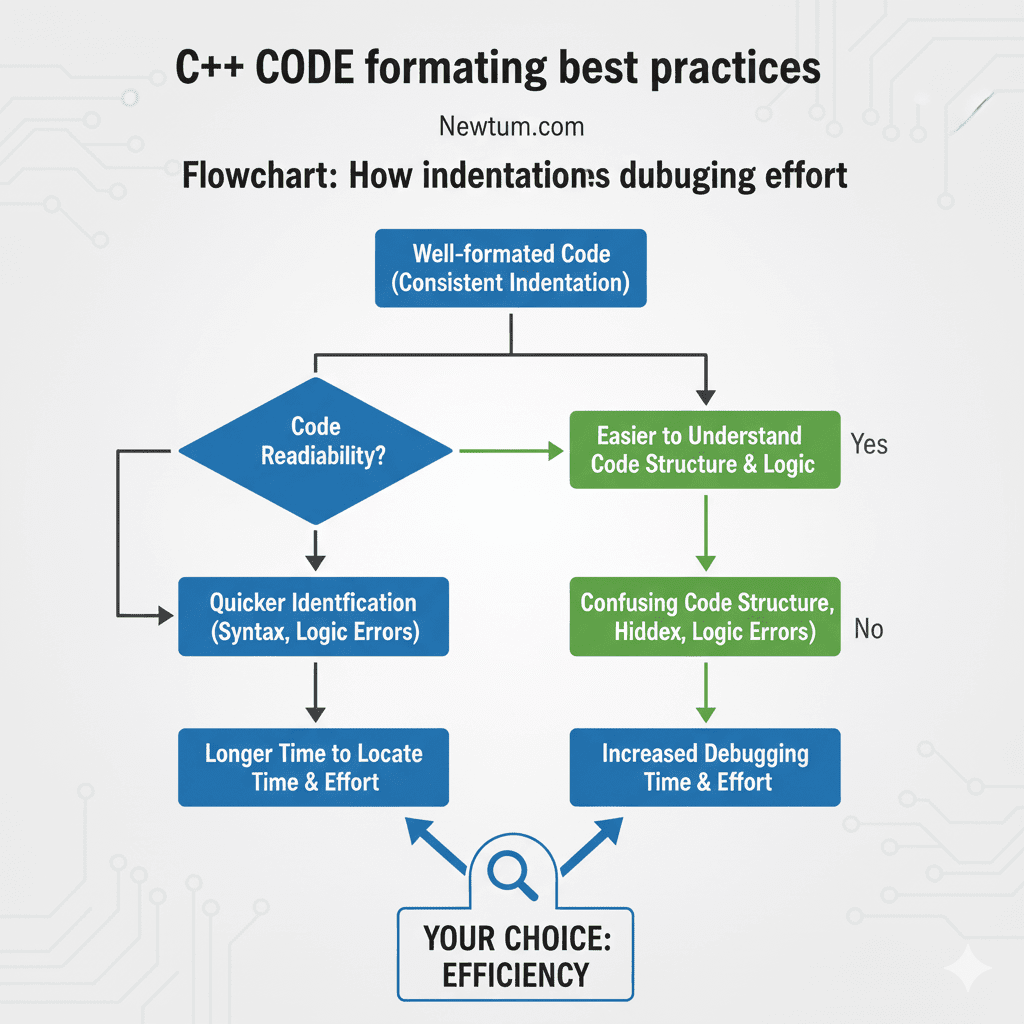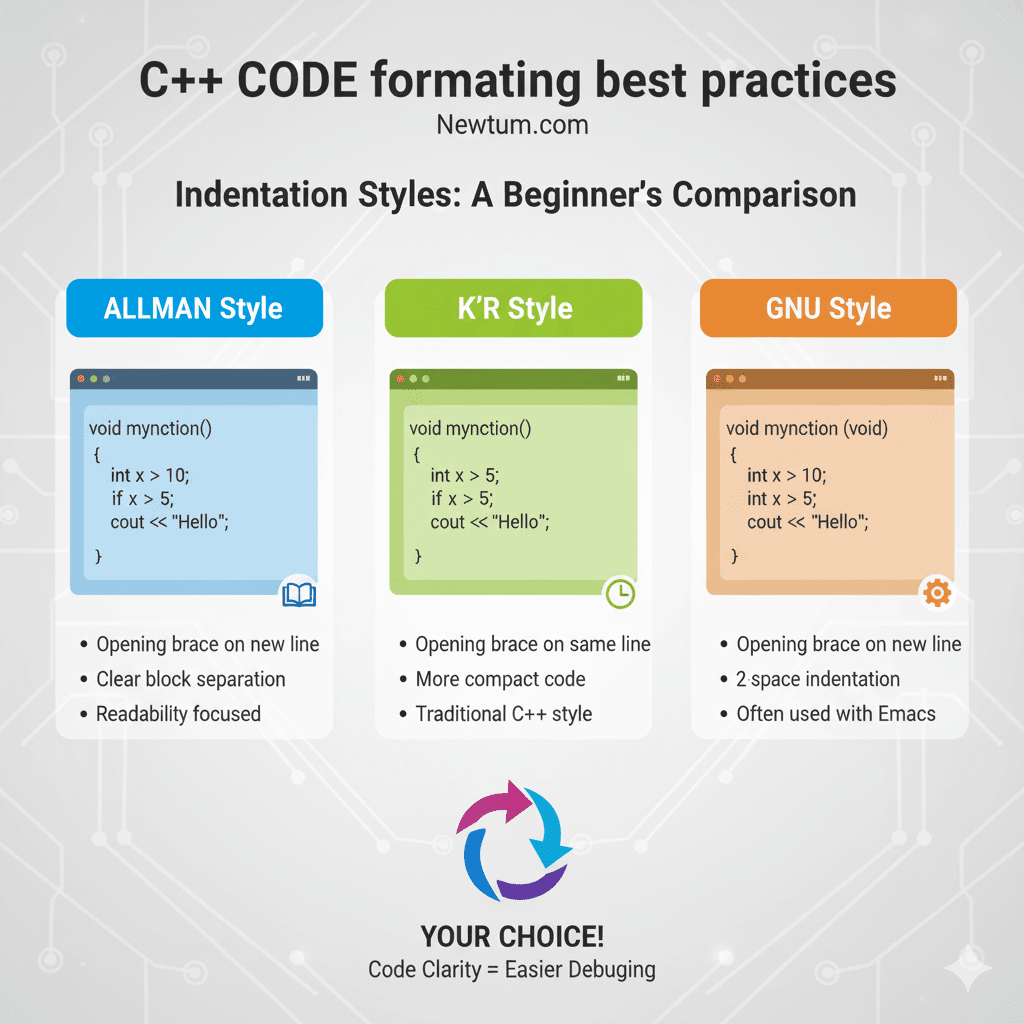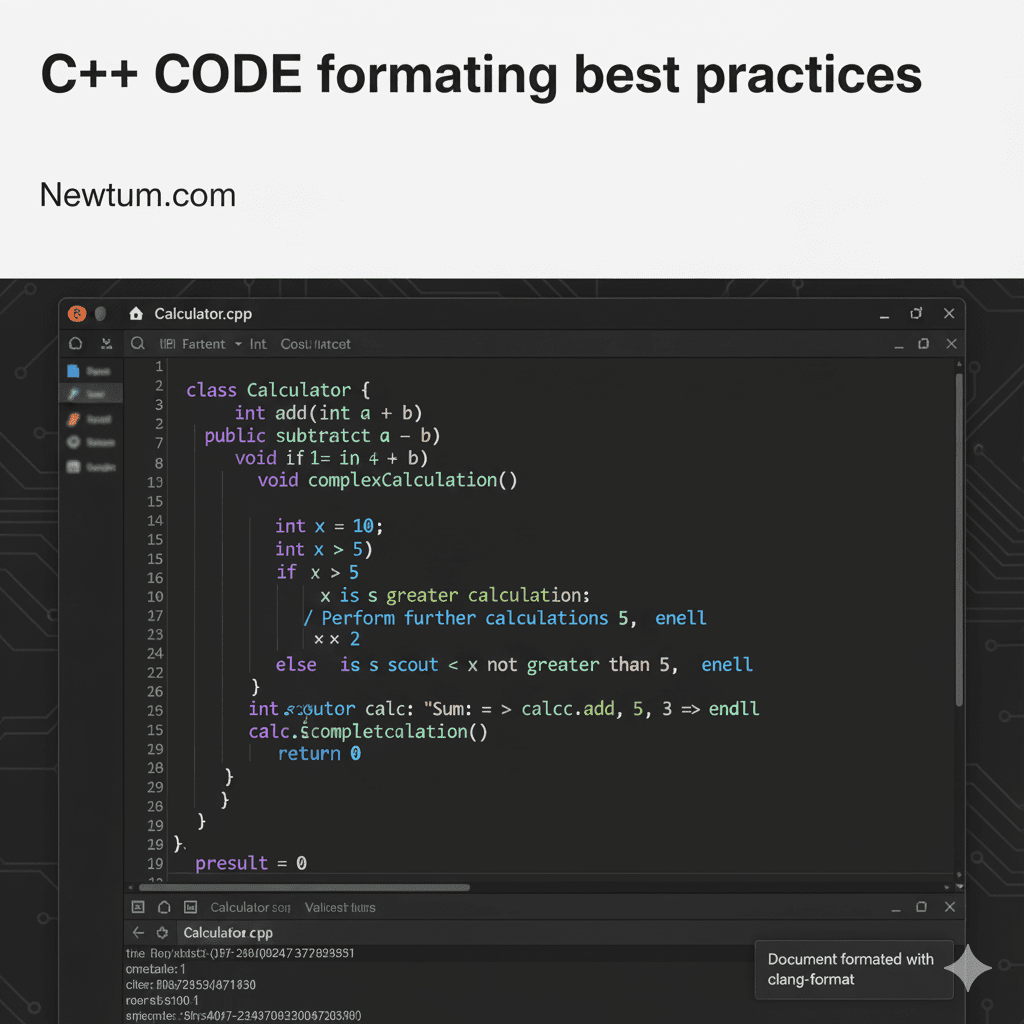C++ indentation best practices involve using consistent spaces or tabs, proper alignment of braces, and clear code formatting. These habits make your code more readable, maintainable, and professional.
Readable code isn’t just about logic—it’s about structure. In today’s collaborative environment, poor indentation in C++ can slow teams down and introduce bugs. By following formatting best practices, you make your code easier to debug, share, and scale.
Quick Summary of C++ Code formatting
- Spaces vs Tabs → Stick to one consistently (commonly 4 spaces).
- Braces → Use Allman or K&R style, but stay consistent.
- Line Length → Keep under 80–100 characters.
- Indent Control Structures → if/else, loops, and switch cases.
- Comment Formatting → Align comments for clarity.
Why Is Indentation Important in C++?
Indentation is not required by the C++ compiler, but it is essential for humans reading the code.
- Readability → Makes it easy for you and others to follow the logic.
- Maintainability → Clean formatting helps when updating or fixing code later.
- Fewer Errors → Clear code structure reduces mistakes, especially with nested loops or conditions.
How to Indent Code in C++ Correctly
Indentation means moving code to the right using spaces or tabs so the structure is clear.

- Tabs vs Spaces
- Tabs are a single press of the tab key.
- Spaces are usually 2 or 4 spaces.
- Best practice: Pick one style (most teams prefer 4 spaces).
- Aligning Braces and Control Statements
if (x > 10) {
cout << "X is greater than 10";
} else {
cout << "X is 10 or less";
}
Notice how braces and inner code are aligned properly.
Formatting Guidelines for C++ Code
A few universal rules make code neater:
- Line Length → Keep each line under 80–100 characters.
- Nesting Levels → Avoid too many nested
iforforloops. Deep nesting makes code harder to follow. - Code Alignment and Comments → Line up your code blocks neatly and place comments above or beside the related code.
Example:
// Calculate total price after tax total = price + (price * taxRate);
What Are the Common Indentation Styles in C++?

Different developers use different brace styles. The important thing is to choose one and stay consistent.
- Allman Style (braces on a new line)
if (x > 0)
{
cout << "Positive";
}
- K&R Style (braces on the same line)
if (x > 0) {
cout << "Positive";
}
- GNU Style (extra indentation for braces)
if (x > 0)
{
cout << "Positive";
}
When Should You Enforce Formatting Rules?
- Team Projects → Everyone should follow the same formatting rules so the code looks uniform.
- Open-Source Contributions → Projects usually have a style guide. Following it increases the chances of your code being accepted.
Pros & Cons of C++ Code Formatting
| Style | Pros | Cons |
|---|---|---|
| Allman | Easy to read, clear blocks | More lines, takes space |
| K&R | Compact, widely adopted | Harder for beginners |
| GNU | Flexible, detailed control | Verbose, less popular |

Applying C++ Code Formatting in Real-Life Coding Scenarios
- Google’s Code Base Organization: Google, a giant in the tech industry, follows strict C++ code formatting practices to maintain their vast codebase. By ensuring consistent style guidelines, developers can read and understand each other’s code quickly.
// Google C++ Style Guide example
void printMessage() {
std::cout << "Hello, Google!" << std::endl;
}
The output of implementing these practices is a streamlined collaborative environment where changes can be made without introducing errors.
- Microsoft’s Compatibility Across Teams: Microsoft uses C++ in many projects, such as Microsoft Office, where code needs to be shared across different teams. By sticking to formatting best practices, they ensure the code remains clean and consistent.
// Microsoft C++ example
int calculate(int a, int b) {
return a + b;
}
The result is seamless collaboration between teams, reducing the risk of bugs due to misunderstood formatting. - Facebook’s Efficient Code Review Process: At Facebook, C++ code formatting best practices are crucial for an efficient code review process. They ensure that all programmers understand the project structure, which boosts productivity.
// Facebook C++ example
class Messenger {
public:
void sendMessage(const std::string &msg);
};
This leads to cleaner code and a faster, more efficient review process, allowing quicker updates and feature rollouts.
Interview Questions about C++ Code Formatting
Q1: Does C++ indentation affect program execution?
A: No, the compiler ignores spaces and tabs. Many beginners worry about execution, but proper indentation only improves readability and maintainability, not performance. Competitors often skip explaining why humans benefit from it.
Q2: How do I choose between tabs and spaces in C++?
A: While the compiler treats them the same, spaces are more consistent across editors and IDEs. Competitors often just say “pick one,” but they don’t explain why spaces reduce formatting issues in team projects or open-source contributions.
Q3: Which indentation style is best for beginners?
A: Beginners should start with K&R style because it is widely used, compact, and easy to read. Most blogs just list styles but don’t give a clear beginner recommendation.
Q4: Can I automate indentation and formatting in C++?
A: Yes! Tools like clang-format or IDE auto-format (Visual Studio, Code::Blocks) can enforce consistent indentation automatically. Competitors rarely explain how beginners can set up these tools for daily use.
Q5: How deep should I indent nested code blocks?
A: Avoid going beyond 3–4 nested levels. Excessive nesting makes code hard to read and debug. Most articles mention indentation but don’t highlight the practical limits for readability.
Q6: Do comments need to follow the same indentation rules?
A: Yes, aligned comments improve readability. For example:
int total = price + tax; // total price after tax
Competitors often ignore how comment alignment interacts with code indentation.
Q7: How does consistent indentation help in team projects?
A: It reduces merge conflicts, makes code review faster, and ensures that all team members can quickly understand logic. Competitors usually skip this real-world team benefit.
Q8: How do I fix indentation in a large C++ file without breaking the code?
A: Use tools like clang-format or Visual Studio auto-format. They parse your code and re-indent safely without changing logic. Competitors often warn about manual fixes but don’t provide safe automation tips.
Q9: Should I indent inside macros or preprocessor directives?
A: Yes, indent for readability, but be cautious—over-indenting macros can make debugging harder. Most articles skip preprocessor formatting tips, leaving beginners confused.
Example:
#define MAX(a,b) \
((a) > (b) ? (a) : (b))
Q10: Can inconsistent indentation cause compilation errors in C++?
A: No, C++ ignores whitespace. But inconsistent indentation often leads to logical errors, especially in nested if/else blocks, which beginners often misread. Competitors rarely clarify this subtle risk.
Q11: How should I format long lines of code in C++?
A: Break lines at operators or after commas for clarity. Align continuation lines with the start of the statement or indent once more. Competitors often just mention line length limits but not how to wrap lines effectively.
Example:
totalPrice = price + tax + shippingCost +
discount - couponValue;
Q12: Is there a “beginner-friendly” tool for checking indentation mistakes?
A: Yes, clang-tidy, Astyle, and IDE built-in linters highlight formatting issues. Many blogs fail to introduce easy-to-use beginner tools for daily coding practice.
Q13: How does indentation help with debugging errors?
A: Properly indented code makes it easier to visually spot misplaced braces, unmatched loops, or misaligned conditions, saving time during debugging. Competitors rarely explain this practical benefit.
Our AI-powered cpp online compiler is a game-changer for developers. Instantly write, run, and test your code with the help of AI, streamlining your coding workflow. It’s perfect for both beginners and seasoned programmers who want to improve efficiency and productivity. Dive in and experience seamless coding today!
Conclusion
Completing ‘C++ Code Formatting Best Practices’ significantly boosts code readability and maintainability. By adopting these practices, you’ll feel a sense of accomplishment in your coding journey. Try it out! For more programming insights and to enhance your skills further in languages like Java or Python, visit Newtum.
Download our C++ Cheat sheet for quick reference.
Edited and Compiled by
This article was compiled and edited by @rasikadeshpande, who has over 4 years of experience in writing. She’s passionate about helping beginners understand technical topics in a more interactive way.



